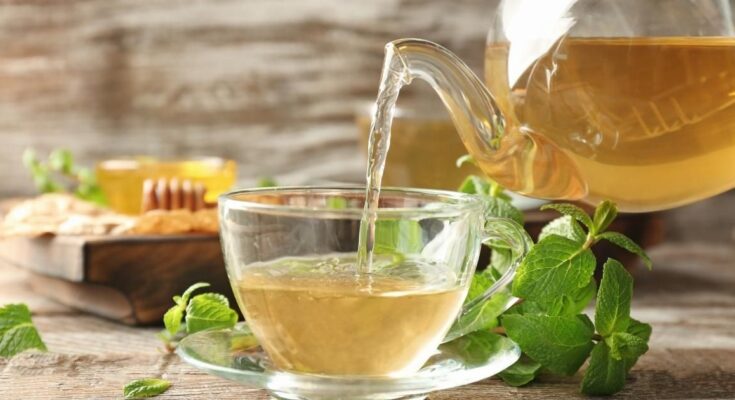Lemon Balm Tea Recipe: Lemon balm (Melissa officinalis) is a member of the mint family, known for its mild lemon scent and calming properties. This herb isn’t just a pretty face in the garden—it’s been used for centuries in traditional medicine and culinary practices. From ancient Greeks to modern-day herbalists, lemon balm has built a reputation as a natural remedy for stress, insomnia, indigestion, and more. The plant’s soft green leaves release a lemony fragrance when crushed, making it a popular choice for teas, tinctures, and even skincare products.
Lemon balm is super easy to grow at home. It’s a perennial herb, meaning once it’s in your garden, it’ll keep coming back each year. Whether you pluck it fresh from your windowsill garden or grab a dried bunch from a local health store, lemon balm is accessible and versatile. And when brewed into tea, it offers a soothing ritual that’s both enjoyable and healthful.
Health Benefits of Lemon Balm Tea
Now, why would you want to sip on lemon balm tea, you ask? Here’s the scoop: this herbal tea is loaded with goodness. For starters, it’s known for its calming effects. Feeling anxious or having trouble winding down after a long day? A warm cup of lemon balm tea can help ease your nerves and improve sleep quality. Scientific studies have backed this up, showing that lemon balm can reduce anxiety and promote relaxation.
But that’s not all—it also aids digestion. If you often deal with bloating, gas, or an upset stomach, lemon balm tea might be your go-to natural remedy. It contains compounds that soothe the digestive tract, making it a gentle yet effective option.
Additionally, it has antiviral properties. Some research suggests that lemon balm can fight off viruses like herpes simplex and boost the immune system. It’s also rich in antioxidants, which protect the body from oxidative stress and help maintain overall wellness.
So yeah, lemon balm tea isn’t just tasty—it’s practically a wellness potion in a cup!
Ingredients Needed for Lemon Balm Tea
Fresh vs. Dried Lemon Balm
When it comes to making lemon balm tea, you’ve got two solid options: fresh or dried leaves. Each has its own charm and benefits.
Fresh Lemon Balm: If you’ve got lemon balm growing in your garden, nothing beats snipping off a few leaves and tossing them into your teacup. Fresh leaves tend to have a more vibrant, citrusy aroma and a mellow taste. For one cup of tea, you’ll need about 1/4 cup of fresh leaves, loosely packed.
Dried Lemon Balm: No garden? No problem. Dried lemon balm is just as effective and often more convenient. You can find it at health food stores, online, or in the herbal section of your local supermarket. Since dried herbs are more concentrated, you’ll only need about 1 tablespoon per cup.
Both versions are great—it just depends on what you have on hand. And honestly, once you start sipping, you’ll be hooked either way.
Optional Ingredients to Enhance Flavor
Lemon balm has a mild flavor, which makes it the perfect base for customization. Want to jazz things up? Try adding one (or more!) of these ingredients:
- Honey or Maple Syrup – For a touch of natural sweetness.
- Lemon or Lime Slices – To double down on the citrus vibe.
- Ginger – Great for an extra zing and digestive support.
- Mint Leaves – A refreshing twist that pairs beautifully with lemon balm.
- Chamomile Flowers – For an even more relaxing experience.
You can experiment with combos until you find your perfect brew. Think of it like creating your own tea blend—because why not?
Tools and Utensils Required
Best Teapots or Infusers to Use
Making tea isn’t rocket science, but having the right tools makes it a lot more enjoyable. Here’s what you might need:
- Teapot with Infuser – Ideal for steeping multiple cups. Look for one with a built-in stainless steel or mesh infuser.
- Tea Ball or Loose Leaf Infuser – Great if you’re making a single cup. These keep your herbs contained while allowing water to flow through freely.
- French Press – Surprisingly effective for herbal teas! Just pop the herbs in, add hot water, steep, and press.
- Mason Jar with Lid – In a pinch, this works just fine. You can strain the tea later using a fine mesh sieve or cheesecloth.
Preparing Your Workspace
Before diving into the tea-making process, take a minute to set the scene. Clean your teapot or cup, lay out your ingredients, and grab a spoon for stirring. If you’re using fresh lemon balm, rinse the leaves gently under cold water and pat dry. For dried herbs, make sure they’re stored in an airtight container and free of moisture or contaminants.
Having everything ready makes the experience smooth and satisfying—just like the tea you’re about to sip.
Step-by-Step Guide to Making Lemon Balm Tea
Step 1: Harvest or Buy Lemon Balm
If you’re harvesting from your garden, pick the leaves in the morning after the dew has dried but before the sun gets too hot. This is when the oils are most concentrated. Use sharp scissors or garden shears and choose the top few leaves—they’re the freshest and most flavorful.
No garden? Head to your local farmers’ market, herbal shop, or trusted online supplier. Look for organic lemon balm to ensure you’re getting the cleanest, chemical-free product.
Step 2: Prepare the Leaves
Once you’ve got your lemon balm leaves—whether freshly picked from your garden or purchased from a store—it’s time to prepare them for brewing. If you’re using fresh leaves, give them a gentle rinse under cool water to remove any dirt or insects. Pat them dry with a clean towel. For dried leaves, ensure they are stored in an airtight container to maintain their potency.
To release the essential oils and enhance the flavor, gently bruise the leaves by rolling them between your fingers or lightly crushing them. This step is crucial as it helps to extract the maximum flavor and therapeutic properties from the leaves during steeping.
Step 3: Boil Water to the Right Temperature
The temperature of the water plays a significant role in the extraction process. Bring fresh, filtered water to a boil, ideally reaching around 200°F (93°C). If you don’t have a thermometer, simply bring the water to a rolling boil and then let it sit for a minute to cool slightly.
Using water that’s too hot can destroy some of the delicate compounds in lemon balm, while water that’s not hot enough may not extract the full range of beneficial properties. So, aim for that sweet spot to get the most out of your tea.
Step 4: Steep the Lemon Balm
Place the prepared lemon balm leaves into your teapot, infuser, or directly into your cup. If you’re using fresh leaves, about 1/4 cup per 8-ounce cup of water is a good ratio. For dried leaves, use approximately 1 tablespoon per cup.
Pour the hot water over the leaves, ensuring they are fully submerged. Cover the teapot or cup to trap the steam and essential oils. Let the tea steep for about 5 to 10 minutes, depending on how strong you like your tea. A longer steeping time will result in a more robust flavor and stronger therapeutic effects.
Step 5: Strain and Serve
After steeping, strain the tea to remove the leaves. If you used an infuser or tea ball, simply remove it from the cup. Pour the tea into your favorite mug and enjoy it as is, or enhance the flavor with a slice of lemon, a sprig of mint, or a teaspoon of honey.
Lemon balm tea can be enjoyed hot or cold. If you prefer iced tea, let it cool to room temperature, then refrigerate it for a few hours. Serve over ice with your choice of garnish for a refreshing beverage.
Tips for Perfect Lemon Balm Tea Every Time
How Long to Steep for Best Flavor
The steeping time can significantly affect the flavor and potency of your lemon balm tea. For a mild, soothing cup, steep the leaves for about 5 minutes. If you prefer a stronger flavor and more pronounced effects, extend the steeping time to 10 minutes. Keep in mind that over-steeping can lead to a slightly bitter taste, so it’s essential to find the right balance that suits your palate.
How to Store Extra Lemon Balm Tea
If you’ve brewed more tea than you can consume in one sitting, storing it properly will preserve its flavor and benefits. Allow the tea to cool to room temperature, then transfer it to a clean, airtight container. Refrigerate the tea and consume it within 2 to 3 days for the best taste and efficacy. Before drinking, give it a good stir or shake, as some settling may occur.
For longer storage, consider freezing the tea in ice cube trays. Once frozen, transfer the cubes to a freezer-safe bag or container. These lemon balm tea cubes can be added to smoothies, iced teas, or used as a refreshing addition to water.
FAQs about Lemon Balm Tea Recipe
Can I drink lemon balm tea every day?
Yes, drinking lemon balm tea daily is generally safe for most people. In fact, regular consumption can help maintain a calm nervous system, promote better sleep, and support digestion. However, if you’re pregnant, breastfeeding, or taking thyroid medications, consult with a healthcare professional before making it a daily habit.
Is lemon balm tea safe for children?
Lemon balm tea is mild and typically safe for children in small amounts, especially when used to help with sleep or tummy troubles. Always use lower doses, and it’s wise to consult your pediatrician before introducing any herbal remedy to your child’s routine.
Can I mix lemon balm tea with other herbs?
Absolutely! Lemon balm pairs beautifully with a variety of herbs. Try it with chamomile for relaxation, peppermint for digestion, or lavender for a soothing night-time tea. Experiment to find the blend that suits your taste and needs best.
What does lemon balm tea taste like?
Lemon balm tea has a light, lemony flavor with subtle herbal notes. It’s refreshing and slightly sweet, making it a pleasant drink both hot and cold. It’s mild enough to be enjoyed on its own but also takes well to additions like honey, lemon, or mint.
How long does fresh lemon balm last?
Fresh lemon balm, when stored properly, lasts about 5–7 days in the refrigerator. Wrap the stems in a damp paper towel and store them in a plastic bag or airtight container. For longer preservation, you can dry the leaves or freeze them for future use.
Conclusion
From its lemony aroma to its soothing effects, lemon balm tea stands out as a wellness staple you can rely on day or night. Whether you’re looking to relax after a stressful day, get better sleep, or simply enjoy a caffeine-free beverage, this tea is a must-have in your routine.
The beauty of lemon balm tea lies not only in its taste and benefits but also in its versatility. Customize it to your liking—sweeten it, spice it up with ginger, or mix it with other herbs. You really can’t go wrong.
So go ahead, brew that cup, and let lemon balm do its magic.



